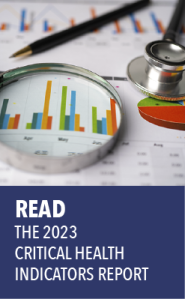Disease surveillance is at the heart of a public health system. It is used to monitor disease trends over time, to detect disease outbreaks, and to increase our knowledge of risk factors that contribute to disease development.
Under Texas law, health care providers, hospitals, laboratories, schools, and others are required to report cases of nearly 80 different diseases and health conditions to local and state health officials.
The Epidemiology and Disease Surveillance Unit receives case reports and collects additional detailed information through case investigation. These reports help public health professionals understand the incidence of diseases in the community, and guide appropriate prevention strategies or protective measures to reduce the spread of disease in the community.
Report a Condition
You can report a disease in Austin/Travis County by phone 24 hours a day, seven days a week. Messages are answered within 15 minutes (on call 24/7).
- Call 512-972-5555
- Fax: 512-972-5772
- 2025 Disease Reporting Packet for Travis County
Disease Categories
- Chronic Conditions
- Disease Reporting
-
You can report a disease in Austin/Travis County by phone 24 hours a day, seven days a week. Messages are answered within 15 minutes (on call 24/7).
- Call 512-972-5555
- Fax: 512-972-5772
- 2025 Disease Reporting Packet for Travis County
- Emerging Conditions
-
Amebic meningitis and encephalitis
Candida auris
Carbapenem-resistant Enterobacterales (CRE)
Legionellosis
Smallpox
Vancomycin-intermediate Staph aureus (VISA)
Vancomycin-resistant Staph aureus (VRSA)
Viral hemorrhagic fever (including Ebola)
MPOX
- Environmental Health & Injuries
-
Dashboards:
- Foodborne Illness
-
Salmonellosis, including typhoid fever
Shiga toxin-producing Escherichia coli
Vibrio
Botulism (adult and infant)
Campylobacteriosis
Cyclosporiasis
Listeriosis
Shigellosis
Yersiniosis
Hemolytic uremic syndrome (HUS)
- HIV, Hepatitis, & Sexually Transmitted Infections
-
HIV/AIDS
Congenital Syphlis
Chlamydia
Gonorrhea
Hepatitis B, C, and E (acute)
Hepatitis B infection identified prenatally or at delivery (mother)
Hepatitis B, perinatal (HBsAg+ <24 months old) (child)
Chancroid
Chlamydia trachomatis infection
Trichuriasis
- Maternal, Child, & Adolescent Health
-
Accordion content.
- Respiratory Diseases
-
Coronavirus, novel
Cronobacter spp. in infants, invasive
Haemophilus influenzae, invasive
- Vaccine Preventable Diseases
-
Chickenpox (varicella)
Diphtheria
Meningococcal infection, invasive (Neisseria meningitidis)
Mumps
Pertussis
Poliomyelitis, acute paralytic
Poliovirus infection, non-paralytic
Rubella (including congenital)
Streptococcal disease (S. pneumo), invasive
Tetanus
- Zoonotic Diseases
-
Arboviral infections
- West Nile Virus
- Dengue
- Malaria
- Eastern Equine Encephalitis
- St. Louis Encephalitis
- Zika Virus
- Oropouche Fever
- Chikungunya
Tickborne and Fleaborne
- Babesiosis
- Rocky Mountain Spotted Fever
- Typhus
- Anaplasmosis
- Ehrlichiosis
- Lyme disease
- Tickborne relapsing fever
Parasitics
- Leishmaniasis
- Ascariasis
- Cysticercosis
- Echinococcosis
- Taenia solium
- Trichinellosis
- Fascioliasis
- Hookworm
- Paragonimiasis
Other Zoonotics
- Anthrax
- Brucellosis
- Chagas disease, human
- Glanders (Burkholderia mellei)
- Hantavirus
- Leptospirosis
- Melioidosis (Burkholderia pseudomallei)
- Plague
- Q fever
- Rabies
- Yellow fever
- Tularemia
More disease information is available from the Centers for Disease Control and Prevention in their A-Z Index of Diseases and Conditions.
HIPAA Compliance
Austin Public Health will comply with all federal and state laws that pertain to any aspect of the clinical practices or business procedures of the Department. In particular, privacy and security rules relating to the Health Insurance Portability and Accountability Act (HIPAA), along with related state laws, are integral to matters of privacy, medical records, the confidentiality of communications, and other topics addressed throughout these policies and procedures.


